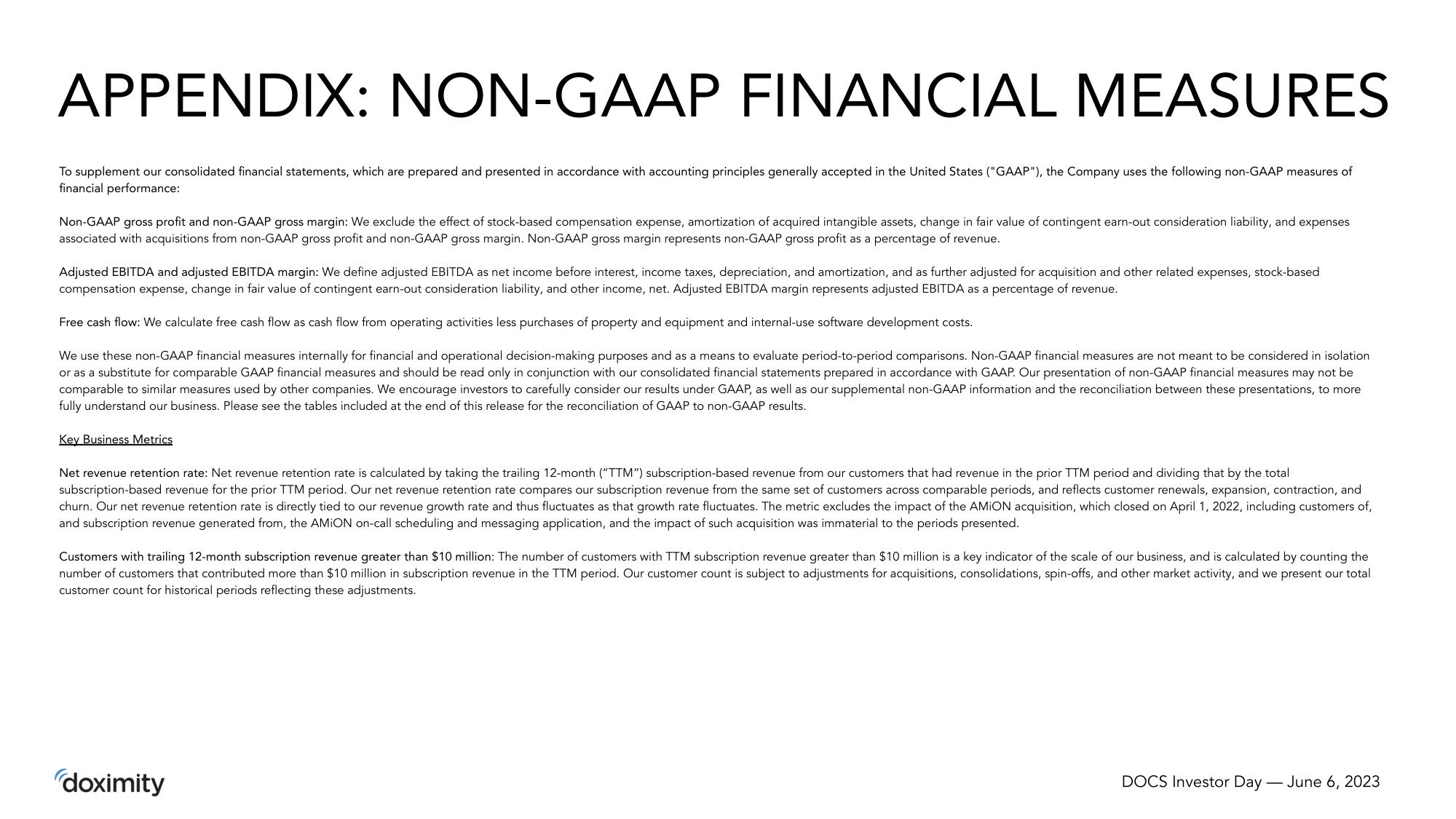Doximity Investor Day Presentation Deck
APPENDIX: NON-GAAP FINANCIAL MEASURES
To supplement our consolidated financial statements, which are prepared and presented in accordance with accounting principles generally accepted in the United States ("GAAP"), the Company uses the following non-GAAP measures of
financial performance:
Non-GAAP gross profit and non-GAAP gross margin: We exclude the effect of stock-based compensation expense, amortization of acquired intangible assets, change in fair value of contingent earn-out consideration liability, and expenses
associated with acquisitions from non-GAAP gross profit and non-GAAP gross margin. Non-GAAP gross margin represents non-GAAP gross profit as a percentage of revenue.
Adjusted EBITDA and adjusted EBITDA margin: We define adjusted EBITDA as net income before interest, income taxes, depreciation, and amortization, and as further adjusted for acquisition and other related expenses, stock-based
compensation expense, change in fair value of contingent earn-out consideration liability, and other income, net. Adjusted EBITDA margin represents adjusted EBITDA as a percentage of revenue.
Free cash flow: We calculate free cash flow as cash flow from operating activities less purchases of property and equipment and internal-use software development costs.
We use these non-GAAP financial measures internally for financial and operational decision-making purposes and as a means to evaluate period-to-period comparisons. Non-GAAP financial measures are not meant to be considered in isolation
or as a substitute for comparable GAAP financial measures and should be read only in conjunction with our consolidated financial statements prepared in accordance with GAAP. Our presentation of non-GAAP financial measures may not be
comparable to similar measures used by other companies. We encourage investors to carefully consider our results under GAAP, as well as our supplemental non-GAAP information and the reconciliation between these presentations, to more
fully understand our business. Please see the tables included at the end of this release for the reconciliation of GAAP to non-GAAP results.
Key Business Metrics
Net revenue retention rate: Net revenue retention rate is calculated by taking the trailing 12-month ("TTM") subscription-based revenue from our customers that had revenue in the prior TTM period and dividing that by the total
subscription-based revenue for the prior TTM period. Our net revenue retention rate compares our subscription revenue from the same set of customers across comparable periods, and reflects customer renewals, expansion, contraction, and
churn. Our net revenue retention rate is directly tied to our revenue growth rate and thus fluctuates as that growth rate fluctuates. The metric excludes the impact of the AMION acquisition, which closed on April 1, 2022, including customers of,
and subscription revenue generated from, the AMION on-call scheduling and messaging application, and the impact of such acquisition was immaterial to the periods presented.
Customers with trailing 12-month subscription revenue greater than $10 million: The number of customers with TTM subscription revenue greater than $10 million is a key indicator of the scale of our business, and is calculated by counting the
number of customers that contributed more than $10 million in subscription revenue in the TTM period. Our customer count is subject to adjustments for acquisitions, consolidations, spin-offs, and other market activity, and we present our total
customer count for historical periods reflecting these adjustments.
doximity
DOCS Investor Day - June 6, 2023View entire presentation